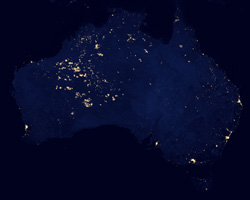Wildfires Light Up Western Australia

This nighttime image of Australia was cropped from the Suomi NPP "Black Marble" released by NASA and the National Oceanic and Atmospheric Administration in December 2012.<br>Credit: NASA Earth Observatory/NOAA NGDC<br>
Away from the cities, much of the night light observed by the NASA-NOAA Suomi NPP satellite in these images comes from wildfires. In the bright areas of western Australia, there are no nearby cities or industrial sites but, scientists have confirmed, there were fires in the area when Suomi NPP made passes over the region. This has been confirmed by other data collected by the satellite.
The extent of the night lights in this area is also a function of composite imaging. These new images were assembled from data acquired over nine days in April 2012 and 13 days in October 2012. This means fires and other lighting (such as ships) could have been detected on any one day and integrated into the composite picture, despite being temporary phenomena.
Because different areas burned at different times when the satellite passed over, the cumulative result in the composite view gives the appearance of a massive blaze. These fires are temporary features, in contrast to cities which are always there.
Other features appearing in uninhabited areas in these images could include fishing boats, gas flaring, lightning, oil drilling, or mining operations, which can show up as points of light. One example is natural gas drilling in the Bakken Formation in North Dakota.
Rani Gran / Michael Carlowicz
NASA's Goddard Space Flight Center, Greenbelt, Md. / NASA Earth Observatory
Media Contact
All latest news from the category: Earth Sciences
Earth Sciences (also referred to as Geosciences), which deals with basic issues surrounding our planet, plays a vital role in the area of energy and raw materials supply.
Earth Sciences comprises subjects such as geology, geography, geological informatics, paleontology, mineralogy, petrography, crystallography, geophysics, geodesy, glaciology, cartography, photogrammetry, meteorology and seismology, early-warning systems, earthquake research and polar research.
Newest articles

Sea slugs inspire highly stretchable biomedical sensor
USC Viterbi School of Engineering researcher Hangbo Zhao presents findings on highly stretchable and customizable microneedles for application in fields including neuroscience, tissue engineering, and wearable bioelectronics. The revolution in…

Twisting and binding matter waves with photons in a cavity
Precisely measuring the energy states of individual atoms has been a historical challenge for physicists due to atomic recoil. When an atom interacts with a photon, the atom “recoils” in…

Nanotubes, nanoparticles, and antibodies detect tiny amounts of fentanyl
New sensor is six orders of magnitude more sensitive than the next best thing. A research team at Pitt led by Alexander Star, a chemistry professor in the Kenneth P. Dietrich…





















